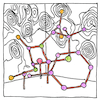Dorothy Hodgkin
pharmacology

|
Structure of penicillin
To use X-rays to determine the atomic and molecular structure of a molecule, the molecule is purified and crystallized, sometimes difficult to do. It’s put in cryogenic helium, placed in a goniometer, and illuminated at several angles by a monochromatic beam of X-rays, each of which produces a two-dimensional image of the defraction pattern, leading to a three-dimensional map of electron density. Electron density and distribution and chemical information help scientists determine the structure of a molecule. Dorothy Hodgkin deduced the structure of penicillin, showing that it has a four-membered beta-lactam ring, which had not been expected, fused to a five-membered thiazolidine ring. The beta-lactam ring is responsible for penicillin’s antibacterial activity.
Adding to the core
To the core structure of penicillin the form that Alexander Fleming found adds a benzyl group, making benzylpenicillin. Other forms of penicillin add other groups to the core, such as procaine benzylpenicillin, benzathine benzylpenicillin, and phenoxymethylpenicillin. The core, also called 6-APA or 6-Aminopenicillanic acid, is the base of several semisynthetic antibiotics that provide better bioavailability, broader spectrum of protection, increased stability, and are more tolerated by patients. Ampicillin, flucloxacillin, dicloxacillin, and methicillin, carbenicillin, ticarcillin, and piperacillin, and cephalosporin.
Chemistry itself
By itself, chemistry tells a chemist what’s in it, but not how its pieces fit together. Chemistry doesn’t say where its pieces come from, or how they meet in this improbable existence.



Dorothy Hodgkin deciphered the structures of penicillin, vitamin B12, and, after working on it for 35 years, insulin.
See also in The book of science:
Readings in wikipedia: